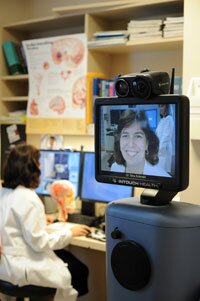FACETIME- Clot doc: Fighting the 'window' in strokes

Dr. Nina Solenski
PHOTO BY JEN FARIELLO
Doctors are presumed empathetic, but sometimes, care improves if you get 'em mad.
Take UVA neurologist Nina Solenski, who early on in her career saw young people fine one moment and completely dysfunctional the next from strokes, something she ruefully calls an equal opportunity brain disease.
"It made me very angry," she says. "Why don't we have a treatment? It's not enough to just be empathetic. It made me want to do research and care."
Today, Solenski, 50, co-chairs the Virginia Stroke Systems Task Force, a collaborative program for improving care after a blood clot in the brain.
She notes that in 2006, strokes killed 3,500 Virginians, and the nearby Central Shenandoah Valley is like the bread basket of strokes.
"It has one of the highest mortalities," says Solenski, "and that could be because it's a rural community."
Odds dramatically improve if the victim gets treatment within a three-hour "window," and in a rural setting, prompt care within that window is hard to find.
That's why Solenski is into robotics.
When a stroke patient comes into the hospital in rural Bath County, Solenski gets paged and can examine the patient from Charlottesville using a robot already installed in Bath.
"They can see me and talk to me," she explains from the telemedicine office in the UVA Medical Center. "I make the decision to treat instead of waiting for the ER doctor to call a helicopter or ambulance to transport them here."
Currently, 62 such sites have been set up in Virginia.
"Dr. Solenski has embraced the use of telemedicine to increase access to high-quality acute stroke care," says Karen Rheuban, head of UVA's Office of Telemedicine. "She has played a tremendous role statewide in engaging all of our providers in this technology."
Typical of neurologists, Solenski's first love is the brain, particularly ways it can localize symptoms to a particular part of the body and how it repairs itself. Her career began at Yale– ironically, washing dishes in a pathology lab to pay for her education at Southern Connecticut State College down the street.
"I came from a lower class family," says Solenski. "I was going to be in the lab. I was never encouraged to do more than get a job."
At Jefferson Medical College in Philadelphia, however, Solenski found mentors. "I was encouraged by these people that I could make a difference," she recalls. "That's when I realized I could get my doctor's degree. I never looked back."
Now also assisting the Virginia Department of Health, Solenski helped kick off an awareness campaign last month because the subtle signs of a stroke don't present the wrenching pain of a heart attack.
She lists changes in speech, difficulty in vision, partial paralysis, numbness, and tingling. Acronyms such as FAST help people remember the signs: Face– droopy, Arm– can you raise it?, Speech– garbled, and Time– that three-hour window.
Awareness is badly needed, says Solenski.
"The natural tendency is to say that will go away– I'll go lie down," she says. "I just admitted someone from the Shenandoah region that didn't recognize stroke symptoms and progressed and now is at a point we are unable to do anything..."
#